Is It Necessary to Replace Lead-acid Batteries with LiFePO4 Batteries?

Lead-acid batteries are well-known and used in many aspects of daily life. As rechargeable batteries, they use lead and sulfuric acid as the electrodes and electrolyte. However, as the demand for such batteries grows, the limitations of lead-acid batteries have become more evident, especially in applications like backup power, marine, RV, and camping. Therefore, finding a better alternative is crucial, and that alternative is the LiFePO4 battery.
Now let's explore why it is necessary to replace lead-acid batteries with LiFePO4 batteries.
Understanding lead-acid batteries and LiFePO4 batteries
Lead-acid batteries are secondary rechargeable batteries that use lead (Pb) and lead dioxide (PbO2) as electrode materials and a sulfuric acid solution as the electrolyte. They are one of the earliest commercially available rechargeable batteries. In comparison, LiFePO4 batteries use lithium iron phosphate (LiFePO4) as the cathode material. LiFePO4 batteries have significant improvements over lead-acid batteries in terms of capacity, weight, lifespan, and maintenance costs, and are widely used in various applications.
Benefits of replacing lead-acid batteries with LiFePO4 batteries
Comparison Items | Lead-acid Battery | LiFePO4 Battery |
Energy Density (Wh/kg) | 30 - 50 | 100 - 150 |
Cycle Life (times) | 300 - 500 | 2000 - 3000 |
Charge-discharge Efficiency | 70% - 85% | 90% - 95% |
Self-discharge Rate | Relatively high, about 20% - 30% per month | Relatively low, about 5% - 10% per month |
Safety | Relatively high risk of leakage and fire | Good thermal stability, high safety |
Environmental Friendliness | Contains heavy metal lead, and improper recycling may pollute the environment | Does not contain heavy metals, relatively environmentally friendly |
Weight | Heavier | Lighter |
Initial Purchase Cost | Lower | Higher |
Better Capacity: Battery capacity is measured in ampere-hours (Ah) or watt-hours (Wh), indicating how much energy the battery can store and provide. The higher the capacity, the longer the battery can be used, although it also depends on the discharge rate and temperature. Typically, a LiFePO4 battery can provide 80% of its rated capacity at a 1C discharge rate and 25°C, while a lead-acid battery can only provide 50%. This means LiFePO4 batteries have about 60% higher capacity. For example, a 12V 100Ah LiFePO4 battery can power a 100W device for 12 hours, while a lead-acid battery can only power the same device for 6 hours.
Reduced Weight: Battery weight is measured in kilograms (kg) or pounds (lbs) and directly impacts battery performance, installation, and transportation. LiFePO4 batteries are typically about 70% lighter than lead-acid batteries. For instance, a 12V 100Ah LiFePO4 battery weighs around 12 kg, while a lead-acid battery weighs about 40 kg. This reduction in weight makes LiFePO4 batteries easier and cheaper to install and transport.
Maximized Lifespan: Battery lifespan refers to the number of charge cycles a battery can undergo before its capacity drops to 80% of the original capacity. LiFePO4 batteries generally have a lifespan 20 times longer than lead-acid batteries. For example, a LiFePO4 battery can last up to 10,000 cycles, while a lead-acid battery can last only 500 cycles. This means LiFePO4 batteries last much longer, reducing the frequency and cost of replacements.
Reduced Maintenance Costs: Battery maintenance refers to the time, money, and effort needed to keep the battery in good condition. LiFePO4 batteries generally have lower maintenance costs than lead-acid batteries. For example, LiFePO4 batteries do not require watering, balancing, or venting, while lead-acid batteries need regular maintenance of these tasks. Therefore, LiFePO4 batteries save time and money on maintenance.
Through this article, we can conclude that replacing lead-acid batteries with LiFePO4 batteries is necessary. LiFePO4 batteries offer better performance, lower costs, and various other benefits. They are also more environmentally friendly and safer, as they do not contain toxic metals or corrosive acids, unlike lead-acid batteries.

